Hi Everyone!! This article will share Palm Tree Questions & Answers.
Written by Rabindranath Tagore, this poem explores the concept of love for motherland. In my previous posts, I have shared the questions & answers of The Drunken Stupor, The Strawberry Pink Villa and The Last Leaf so, you can check these posts as well.
Palm Tree Questions & Answers
Question 1: Why does the poet call the palm-tree a single legged giant?
Answer: The poet calls the palm tree a ‘single-legged giant’ because the tree stands tall like a giant, on its one leg which is its trunk.
Question 2: Read and answer the questions:
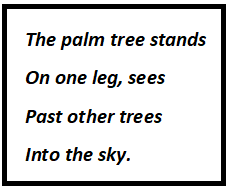
(a) What do these lines tell us?
Answer: These lines tell us that the tree is taller than the other trees.
(b) What does ‘one leg’ signify?
Answer: One leg signifies the trunk of the tree.
(c) What is the action that the poet imagines the tree doing?
Answer: The poet imagines the tree to be a bird. He imagines that the tree is flying like a bird with the help of its fronds.
Question 3: What would the palm tree do if it had wings? Where would it go?
Answer: If the palm tree had wings, it would fly away up in the sky and pierce the black cloud- ceiling. It would go to unknown places wheeling past the stars.
Question 4: How does the palm tree express its wish? Explain the meaning of ‘rising on their flutter’.
Answer: The palm tree expresses its wish by tossing about its head in the wind. By ‘rising on their flutter’ the poet means that the palm tree would make use of its fronds as wings, and flutter these fronds to rise high up in the sky.
Question 5: Read and answer the questions:
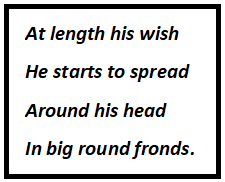
(a) What according to the poet, does the tree wish?
Answer: The tree wishes to be free, to fly like a bird. It does not want to be confined at a place.
(b) In the poet’s imagination, what does the tree think about its fronds?
Answer: In the poet’s imagination, the tree thinks about its fronds to be its wings.
(c) What does the poet compare the palm tree to? How apt is this comparison?
Answer: He compares the palm tree to a human being. Thus, personification is used. Then, he compares it to a bird. This comparison is quite apt as similarity between the palm tree and human beings can be seen. Both feel that they are superior and they wish of that which they don’t have. Both feel unsatisfied very often.
Palm Tree Questions & Answers
Question 6: Pick out the words that convey the sound made by the moving leaves. Which figure of speech is being used here by the poet?
Answer: The words that convey the sounds made by moving of the leaves are heave, swish, flutter and flap. The figure of speech used here is onomatopoeia.
Question 7: What does the tree imagine its leaves to be? What would it now be able to do?
Answer: The tree imagines its leaves to be wings. If it were so, it would be able to flap these wings and fly high up in the sky.
Question 8: How does the tree move in the wind? Write the words that convey its movements.
Answer: The strong wind moves the palm tree with its force. The words from the poem that convey this movement are: tossing, heave, swish, flutter, flap, and shudder.
Question 9: Read and answer the questions:
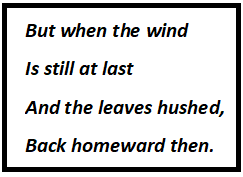
(a) Where do the thoughts of the tree turn?
Answer: In the last stanza, the thoughts of the tree turn towards the mother earth.
(b) What does the poet mean by ‘when the wind is still’?
Answer: It means when the winds stop blowing.
(c) Where was the mind of the tree before this?
Answer: Before this, the mind of the tree was surrounded by stars, skies and things of the space. It was thinking of its flight.
Question 10: Read and answer the questions:
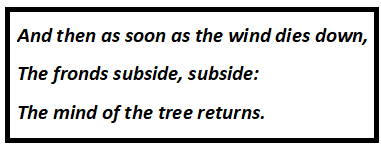
(a) Why does the poet repeat the word ‘subside’?
Answer: The poet repeats the word ‘subside’ twice to show the gradual change in the palm tree’s behaviour as the wind dies down.
(b) Explain ‘the mind of the tree returns’. Where had it gone??
Answer: The mind of the tree had been wandering in the skies, imagining that it was flying there. The mind of the tree had gone to unknown places past the stars. But as the wind dies down, the mind of the tree returns to where it belongs.
(c) What does the palm tree recall as soon as the wind dies? Where does it return to?
Answer: As soon as the wind dies, the palm tree recalls that the sky is not where it belongs, and that the earth is its mother. It returns back to the earth, its mother, its home.
Question 11: Write down two instances where the poet has used personification.
Answer: Two instances where the poet has used personification are:
i. The tree seems to express its wish in the tossing of its head.
ii. The mind of the tree returns to earth, recalls that earth is its mother.
Question 12: What do you think the return of the palm tree to the earth signifies?
Answer: The return of the palm tree to the earth signifies the importance of motherland. After the wind stops, the tree realizes that it belongs to the earth that is its mother. It implies that after all the adventures and wandering, it is one’s home that gives one the real repose.
Question 13: Read and answer the questions:
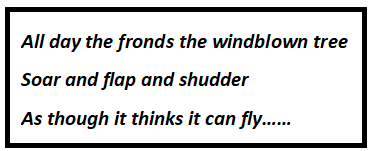
(a) What are ‘fronds’?
Answer: Fronds are the leaves of the palm tree.
(b) What does the palm tree imagine it can do?
Answer: The palm tree imagines that it can fly using its leaves as wings.
(c) Where does it wander? Where does it travel to?
Answer: It imagines that it wanders in the skies and travels to unknown places past the stars.
So, these were Palm Tree Questions & Answers.